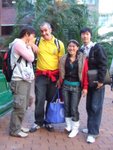Reflections
The contents of the University of Southern Queensland (USQ) course, entitled: Internet Based Language Instruction (LIN8016) has helped me analyse the various components of Internet based teaching, such as computer-mediated communication (CMC). CMC and its use in the language classroom or lab is an integral part of any course. CMC can help teachers get in touch with other CALL teachers around the world, so they can share each other’s resources; our most important resource of course is our student group. Students can use CMC to practice listening, pronunciation and oral skills, reading, writing, which all encompass the key elements of vocabulary and grammar. Many scholars have done extensive psychological tests that prove that extensive use of CMC can actually improve students’ motivation, attitude, and confidence when speaking in the target language, and when speaking to native speakers of the target language (Hadley, 2001). In addition to CMC, I also enjoyed the pace of the course. The course designer has taken careful consideration to the fact that we are not webmasters, but EFL teachers. The course began with an introduction to the Internet, its history, defining Internet terms, as well as good search engines. These are items that most of our students should know more about than us, so it is a necessary basis for “experienced” teachers. The online discussions were very helpful, noticeably so when we had problems, other students were always available and willing to clarify concerns. We are all dealing with this course online, so it was great for many of us to work in collaboration, as a support network, in a manner of speaking. Some students were very willing to add comments, which gave further information on important matters in the IBLI and computer asssited language learning (CALL) universe.
My experience in using the Internet really began in 1997, when I coincidentally entered the TESOL work force. I initially began with simple email, and was then introduced to Dave’s ESL Café, where I learned quite a bit from other teachers, and from resources made available by our guru, Dave Sperling. I also used Pusanweb for job adverts and things for sale in the classified section. While in Tainan, Taiwan, I often visited the Tainan Bulletin, a kind of CMC discussion board offered in Yahoo Groups, very similar to Pusan Web. I taught a CD-ROM listening class at Dong-Seo University, in Busan, South Korea, and at Nan-Tai University, in Yong-Kang, Taiwan. My internet usage was limited to email, and surfing, until I came to USQ. In the prerequisite course to IBLI, called CALL (LIN 8006), we learned about various ways to use the Internet and courseware in our language classes. In CALL, and now IBLI, a new window has been opened to the vortex of information, lessons, and ideas out there for the language classroom. From movie sites, to pronunciation software, to CMC, the computer and the internet are now at the forefront of the language classroom, and we as educators must stay online with future developments.

